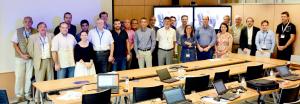Design of European Test Blanket Modules reviewed
The ITER Test Blanket Module (TBM) program has begun to transition from scientific research to nuclear engineering and realization. Conceptual design work is currently underway on all six Test Blanket Systems planned for testing on ITER.
From 8 to 12 June, 30 experts came together in Barcelona to review the conceptual design of two TBM concepts put forward by Europe: the Helium-Cooled Pebble-Bed (HCPB) and the Helium-Cooled Lead Lithium (HCLL). (The key difference lies in the type of materials used for the tritium breeder.) By testing tritium concepts on ITER in a real fusion environment, scientists have a unique opportunity to explore the most promising techniques for tritium breeding that will be a critical technology for next-phase fusion devices.
See the original article on the European Domestic Agency website.


